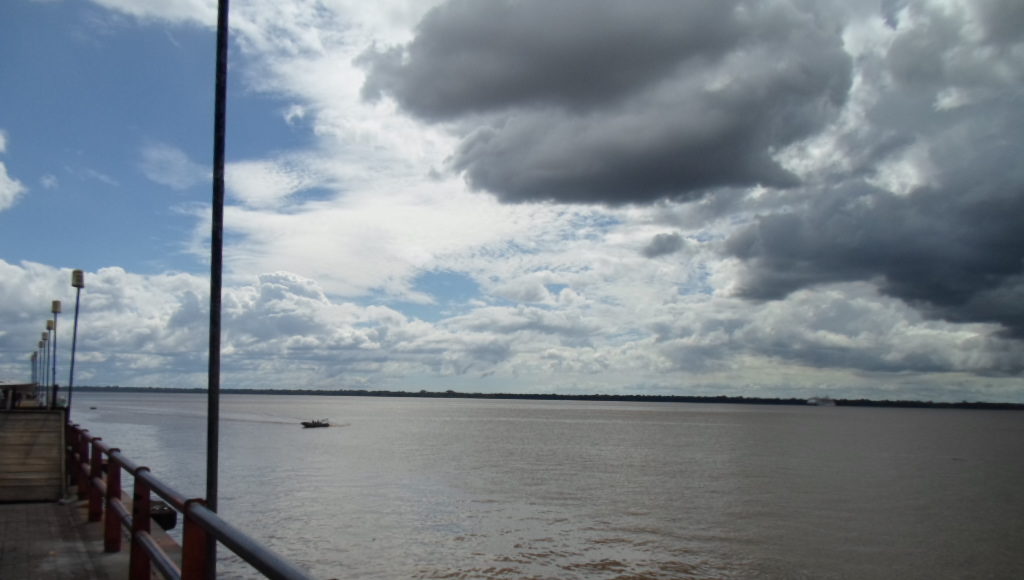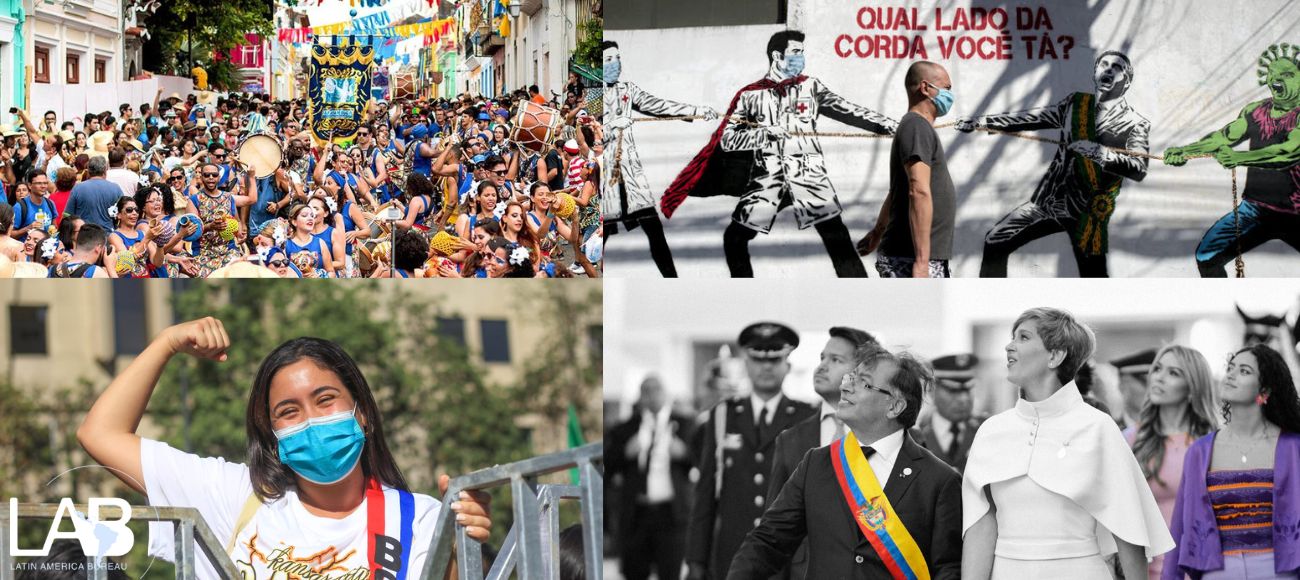About six weeks ago, I said Recife had ‘water, water everywhere’, but I’d forgotten about Belém! Here, where the Amazon flows into the Atlantic, the scale is totally different. As you fly in from the south, you see rivers on all sides, sizable enough to my eyes, but then they merge into this huge expanse of water that greets the onlooker on the Belém river-front, site of the famous Ver-o-peso market, which is largely a tourist attraction these days, though you do see local people leaving it with plastic bags of fruit and veg.
The other feature that strikes from the air is the green, a much darker shade than in the north-east: around Belém at least, you get the sense that the forest is very much a presence, in contrast with Marabá. A pleasant feature of Belém, at least the centre, is the number of squares with gardens, often overgrown, but presumably a legacy of the wealth created by the rubber boom of the end of the 19th century But there is also an insurrectionary tradition in Belém, which was the centre of the revolt known as the cabanagem that broke out in 1835. In recent weeks the dockers of Belém have been protesting against the federal government’s plan to allow more private companies to run port facilities: according to the government, loading and unloading cargoes at Brazilian ports is slower and more expensive than in many other countries.
 I also had an experience in Belém that made me wonder whether a socialist consciousness is widespread in the city. I got on a bus and asked the conductor at the turnstile – that characteristic feature of urban buses in Brazil – what the fare was. To my surprise, he replied: ‘If you’re over 60, you can stay in the front.’ (the equivalent of the Freedom Pass here). Not only that, but as I was getting off he made a point of saying, ‘On any bus in Belém, stay in the front. It’s your right.’ And I presume he could tell I wasn’t Brazilian. That certainly doesn’t happen in Recife.
I also had an experience in Belém that made me wonder whether a socialist consciousness is widespread in the city. I got on a bus and asked the conductor at the turnstile – that characteristic feature of urban buses in Brazil – what the fare was. To my surprise, he replied: ‘If you’re over 60, you can stay in the front.’ (the equivalent of the Freedom Pass here). Not only that, but as I was getting off he made a point of saying, ‘On any bus in Belém, stay in the front. It’s your right.’ And I presume he could tell I wasn’t Brazilian. That certainly doesn’t happen in Recife.
One sight I wanted to see in Belém, was the natural history museum Emílio Goeldi. The most striking feature is its garden, a mini-tropical forest with animals in cages – rather small by modern standards – scattered around: perhaps most impressive are the cheetahs. The museum is developing its scientific side, and has just completed a list of species in Pará state, part of a national biodiversity census. One detail of this caught my eye. There was a feature on the
pau cravo tree, various parts of which have the flavour of cinnamon and cloves. According to the scientists it was harvested to near extinction, and there are now only two populations known in Brazil. One, apparently, is in Vitória do Xingú, in the region of Belo Monte. How long will that last, I wondered, as the huge hydro-electric scheme is completed, with its accompanying urbanisation.
 Belém also has a small art gallery, near the cathedral down by the harbour. In the Green Room, along with the 18th and 19th century furniture, there is an imposing painting claiming to show ‘The Last Days of Carlos Gomes’, the Brazilian composer best known for his opera O Guaraní. There are also some examples of the modernist movement in Brazilian art that for the first time treated poor people as proper subjects for works of art.
Belém also has a small art gallery, near the cathedral down by the harbour. In the Green Room, along with the 18th and 19th century furniture, there is an imposing painting claiming to show ‘The Last Days of Carlos Gomes’, the Brazilian composer best known for his opera O Guaraní. There are also some examples of the modernist movement in Brazilian art that for the first time treated poor people as proper subjects for works of art.
On to Marabá, where I decided to stay the night, remembering the rough ride I had last year by minibus to Xinguara. I asked my taxi-driver to find me a cheap hotel near the river, which meant staying in ‘old Marabá’ or – as the locals prefer to call it – ‘Marabá Pioneira’, a choice fully justified by the magnificent view you get over the Tocantins river from the numerous riverside restaurants. My memories of the ride to Xinguara held up. Even in daylight on a dry day, the 230km took us five and a half hours as opposed to the 3hrs 20min the travel websites say it should.
Xinguara is rancher country. The main road is lined by ranches, and every little place seems to have a show ground for cattle auctions. But my destination is very different, the house of Frei Henri des Roziers, a French Dominican priest who has worked here for 30 years with the Catholic Church’s Pastoral Land Commission (CPT). The CPT started off as an organisation defending the rights of small farmers and rural workers against the violence of the rich, and was a bit uneasy about the activism of the Landless Rural Workers Movement (MST), which promoted occupations of unproductive land. These days, though, the two movements seem to work together, though the CPT’s role seems to be to provide legal and strategic advice to communities occupying land.
I witnessed this in action last Sunday (24 February), when Frei Henri was called on to intervene in a land occupation near Redenção, two hours’ drive south of Xinguara. The occupation leader was apparently selling plots to other people – illegal, because whoever owns the land it’s not him and unethical by the criteria of the land reform movement. He had apparently been claiming Frei Henri’s support, Frei Henri being a respected figure among the social movements here. Frei Henri, who has difficulty walking these days, was hoisted on to the back of a truck, and charmed his audience, insisting that they needed a proper committee and commenting that their leader had caused trouble in other occupations. As I watched this frail figure suddenly energised by his contact with the people, I felt I saw the priest denounced in France post-1968 as a ‘Maoist’ in action again – though, to be fair, his approach was more Franciscan than Maoist. But this Dominican dove certainly had the cunning of a serpent, as recommended in the Gospel (Matthew 10.16).
J

ust before our trip to Redenção, I accompanied Frei Henri to a late birthday party, organised for him by the police officers who used to be his bodyguards. There must have been about 30 people there, including wives, children and partners. One of the police officers said to me, ‘When we first heard of Frei Henri, we heard he was a trouble-maker. But now it’s different.’ Their only regret was that Henri wouldn’t stay all afternoon, because he had agreed to go to the meeting in Redenção.
 I also had an experience in Belém that made me wonder whether a socialist consciousness is widespread in the city. I got on a bus and asked the conductor at the turnstile – that characteristic feature of urban buses in Brazil – what the fare was. To my surprise, he replied: ‘If you’re over 60, you can stay in the front.’ (the equivalent of the Freedom Pass here). Not only that, but as I was getting off he made a point of saying, ‘On any bus in Belém, stay in the front. It’s your right.’ And I presume he could tell I wasn’t Brazilian. That certainly doesn’t happen in Recife.
One sight I wanted to see in Belém, was the natural history museum Emílio Goeldi. The most striking feature is its garden, a mini-tropical forest with animals in cages – rather small by modern standards – scattered around: perhaps most impressive are the cheetahs. The museum is developing its scientific side, and has just completed a list of species in Pará state, part of a national biodiversity census. One detail of this caught my eye. There was a feature on the pau cravo tree, various parts of which have the flavour of cinnamon and cloves. According to the scientists it was harvested to near extinction, and there are now only two populations known in Brazil. One, apparently, is in Vitória do Xingú, in the region of Belo Monte. How long will that last, I wondered, as the huge hydro-electric scheme is completed, with its accompanying urbanisation.
I also had an experience in Belém that made me wonder whether a socialist consciousness is widespread in the city. I got on a bus and asked the conductor at the turnstile – that characteristic feature of urban buses in Brazil – what the fare was. To my surprise, he replied: ‘If you’re over 60, you can stay in the front.’ (the equivalent of the Freedom Pass here). Not only that, but as I was getting off he made a point of saying, ‘On any bus in Belém, stay in the front. It’s your right.’ And I presume he could tell I wasn’t Brazilian. That certainly doesn’t happen in Recife.
One sight I wanted to see in Belém, was the natural history museum Emílio Goeldi. The most striking feature is its garden, a mini-tropical forest with animals in cages – rather small by modern standards – scattered around: perhaps most impressive are the cheetahs. The museum is developing its scientific side, and has just completed a list of species in Pará state, part of a national biodiversity census. One detail of this caught my eye. There was a feature on the pau cravo tree, various parts of which have the flavour of cinnamon and cloves. According to the scientists it was harvested to near extinction, and there are now only two populations known in Brazil. One, apparently, is in Vitória do Xingú, in the region of Belo Monte. How long will that last, I wondered, as the huge hydro-electric scheme is completed, with its accompanying urbanisation.
 ust before our trip to Redenção, I accompanied Frei Henri to a late birthday party, organised for him by the police officers who used to be his bodyguards. There must have been about 30 people there, including wives, children and partners. One of the police officers said to me, ‘When we first heard of Frei Henri, we heard he was a trouble-maker. But now it’s different.’ Their only regret was that Henri wouldn’t stay all afternoon, because he had agreed to go to the meeting in Redenção.
ust before our trip to Redenção, I accompanied Frei Henri to a late birthday party, organised for him by the police officers who used to be his bodyguards. There must have been about 30 people there, including wives, children and partners. One of the police officers said to me, ‘When we first heard of Frei Henri, we heard he was a trouble-maker. But now it’s different.’ Their only regret was that Henri wouldn’t stay all afternoon, because he had agreed to go to the meeting in Redenção.


